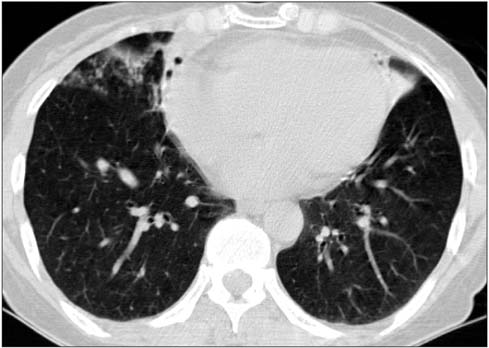Tuberc Respir Dis.
2015 Oct;78(4):416-418. 10.4046/trd.2015.78.4.416.
Nontuberculous Mycobacterial Lung Disease Caused by Mycobacterium shinjukuense: The First Reported Case in Korea
- Affiliations
-
- 1Division of Pulmonary and Critical Care Medicine, Department of Medicine, Samsung Medical Center, Sungkyunkwan University School of Medicine, Seoul, Korea. wjkoh@skku.edu
- 2Department of Radiology, Samsung Medical Center, Sungkyunkwan University School of Medicine, Seoul, Korea.
- 3Korean Institute of Tuberculosis, Osong, Korea.
- 4Department of Microbiology, Yonsei University College of Medicine, Seoul, Korea.
- KMID: 2320718
- DOI: http://doi.org/10.4046/trd.2015.78.4.416
Abstract
- Mycobacterium shinjukuense is a novel species of nontuberculous mycobacteria (NTM) that was first reported in Japan in 2011. It is a slow-growing NTM pathogen that can cause chronic pulmonary infections. There are only a few reported cases of M. shinjukuense infections, all of which are from Japan. We reported a case of chronic lung disease caused by M. shinjukuense. The organism was identified by 16S rRNA, rpoB, and hsp65 gene sequencing. To the best of our knowledge, this was the first confirmed case of lung disease caused by M. shinjukuense outside of Japan.
Figure
Reference
-
1. Kendall BA, Winthrop KL. Update on the epidemiology of pulmonary nontuberculous mycobacterial infections. Semin Respir Crit Care Med. 2013; 34:87–94.2. Morimoto K, Iwai K, Uchimura K, Okumura M, Yoshiyama T, Yoshimori K, et al. A steady increase in nontuberculous mycobacteriosis mortality and estimated prevalence in Japan. Ann Am Thorac Soc. 2014; 11:1–8.3. Koh WJ, Chang B, Jeong BH, Jeon K, Kim SY, Lee NY, et al. Increasing recovery of nontuberculous mycobacteria from respiratory specimens over a 10-year period in a tertiary referral hospital in South Korea. Tuberc Respir Dis. 2013; 75:199–204.4. Kwon YS, Koh WJ. Diagnosis of pulmonary tuberculosis and nontuberculous mycobacterial lung disease in Korea. Tuberc Respir Dis. 2014; 77:1–5.5. Griffith DE, Aksamit T, Brown-Elliott BA, Catanzaro A, Daley C, Gordin F, et al. An official ATS/IDSA statement: diagnosis, treatment, and prevention of nontuberculous mycobacterial diseases. Am J Respir Crit Care Med. 2007; 175:367–416.6. Saito H, Iwamoto T, Ohkusu K, Otsuka Y, Akiyama Y, Sato S, et al. Mycobacterium shinjukuense sp. nov., a slowly growing, non-chromogenic species isolated from human clinical specimens. Int J Syst Evol Microbiol. 2011; 61:1927–1932.7. Futatsugi K, Nishio K, Aida S, Okabayashi K, Nakano Y, Ryuzaki M, et al. Case report: a case of pulmonary infectious disease due to Mycobacterium shinjukuense. Nihon Naika Gakkai Zasshi. 2011; 100:3637–3639.8. Watanabe K, Shinkai M, Yamaguchi N, Shinoda M, Hara Y, Ishigatsubo Y, et al. Mycobacterium shinjukuense lung disease that was successfully treated with antituberculous drugs. Intern Med. 2013; 52:2653–2655.9. Oshima K, Yokouchi H, Minemura H, Saito J, Tanino Y, Munakata M. Pulmonary infection caused by Mycobacterium shinjukuense. Ann Am Thorac Soc. 2015; 12:958–959.10. Wang HY, Bang H, Kim S, Koh WJ, Lee H. Identification of Mycobacterium species in direct respiratory specimens using reverse blot hybridisation assay. Int J Tuberc Lung Dis. 2014; 18:1114–1120.11. Wang HY, Kim H, Kim S, Kim DK, Cho SN, Lee H. Performance of a real-time PCR assay for the rapid identification of Mycobacterium species. J Microbiol. 2015; 53:38–46.12. Turenne CY, Tschetter L, Wolfe J, Kabani A. Necessity of quality-controlled 16S rRNA gene sequence databases: identifying nontuberculous Mycobacterium species. J Clin Microbiol. 2001; 39:3637–3648.13. Telenti A, Marchesi F, Balz M, Bally F, Bottger EC, Bodmer T. Rapid identification of mycobacteria to the species level by polymerase chain reaction and restriction enzyme analysis. J Clin Microbiol. 1993; 31:175–178.14. Devulder G, Perouse de Montclos M, Flandrois JP. A multigene approach to phylogenetic analysis using the genus Mycobacterium as a model. Int J Syst Evol Microbiol. 2005; 55(Pt 1):293–302.15. Somoskovi A, Salfinger M. Nontuberculous mycobacteria in respiratory infections: advances in diagnosis and identification. Clin Lab Med. 2014; 34:271–295.
- Full Text Links
- Actions
-
Cited
- CITED
-
- Close
- Share
- Similar articles
-
- Respiratory Review of 2009: Nontuberculous Mycobacterium
- A Case of Mycobacterium Abscessus Spondylitis
- A Case of Mycobacterium abscessus Lung Disease in a Patient with Cystic Fibrosis
- Nontuberculous Mycobacterial Lung Disease Caused by Mycobacterium lentiflavum in a Patient with Bronchiectasis
- Nontuberculous Mycobacterial Lung Disease Caused by Mycobacterium terrae in a Patient with Bronchiectasis



